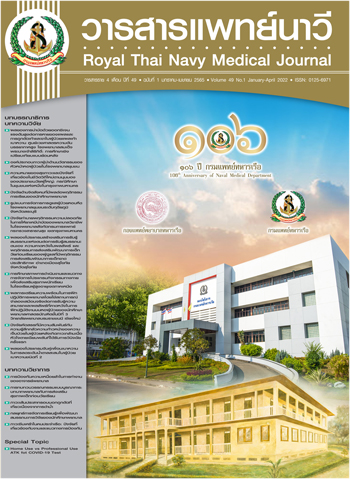Burnout Prevention among Nursing Instructors
Main Article Content
Abstract
Burnout is a result of accumulated stress over a long period of time, which is mostly found among public health personnel. This is because of the stress-related workload and pressure. A person who has burnout would show three main symptoms: emotional exhaustion, depersonalization, and decreased occupational accomplishment. These indications would lead to a lack of motivation and interest in the roles that an individual would have fully enjoyed. Resulting in reduced performance in the organization, finally they would resign from their job. However, burnout can be prevented at both the individual and corporate levels. This would help the person to develop commitment, focus, goals, and happiness in their work; thus, this would result in greater work efficiency and achieving the vision of the organization. Therefore, this article aimed to present a definition of burnout, the associated factors of burnout, symptoms of burnout, effects of burnout, working phases leading to burnout, and an investigation and the prevention of burnout.
Article Details

This work is licensed under a Creative Commons Attribution-NonCommercial-NoDerivatives 4.0 International License.
References
Maslach C, Jackson SE. Burnout in health profession: a social psychological analysis. In: Sanders GS, Suls J, editors. Social psychology of health and illness. San Francisco: L. Erlbaum Associates; 1982. p. 227-51.
Maslach C. Burnout: the cost of caring. Englewood Cliffs: N.J. Prentice Hall; 1982.
Youngsri C. Perception of working environment: burnout and turnover intentions of employees. Bangkok: Industrial and Organizational Psychology King Mongkut’s Institute of Technology North Bangkok; 2006. (in Thai).
Ames SE, Cowan JB, Kenter K, Emery S, Halsey D. Burnout in orthopedic surgeons: a challenge for leaders, learners, and colleagues: AOA critical issues. J Bone Joint Surg Am 2017;99(14):e78.
Jearong K, Srivichai C. Relationship between working environment factors and burnout of nurses, community hospital of Pathumtani province. Journal of The Royal Thai Army Nurses 2017;18(Suppl2):299-305. (in Thai).
Putra KR, Setyowati S. Prevalence of burnout syndrome among nurses in general hospitals in provincial East Java: cross-sectional study. Enferm Clin 2019;29(Suppl2):362-6.
Pokasem B, Chaimongkol N. Factors predicting happiness in work of nursing faculties. The Journal of Faculty of Nursing Burapha University 2014;22(4):13-24. (in Thai).
Suksawan T, Sangsawang K, Rueangrit P. Relationship between work-related factors, family and social-related factors and burnout of nurse lecturers in Boromarajonani College of Nursing in northern region under supervision of Praboromarajchanok Institute. Journal of Health Science Research 2011;5(1):40-7. (in Thai).
Phaktoop M, Saradhuldhat G. Shortage and retention of nurse educators in education institutions. Journal of Nursing and Education 2018;11(3):1-9. (in Thai).
Freudenberger HJ. Staff burn-out. J Soc Issues 1974;30:159-65.
Potter BA. Preventing job burnout. Illinois: Crip Publications; 1997.
Sereesitthipitak V. Burnout: definition, inventory, prevention and intervention. Journal of Somdet Chaopraya Institute of Psychiatry 2007;1(2):121-30. (in Thai).
Summawart S. Burnout of staff nurses at Ramathibodi Hospital. [Master’s Thesis, Faculty of Nursing]. Mahidol University; 1989. (in Thai).
Yongcharoen P, Sithisarankul P. Prevalence and associated factors of burnout syndrome among ship officers of the Royal Thai Navy. Royal Thai Navy Medical Journal 2020;47(1):204-22. (in Thai).
Leelukkanaveera Y, Longphimai C, Toonsiri C. Influencing factors of stress among the Royal Thai Navy in Narathiwat province. Royal Thai Navy Medical Journal 2018;45(2):399-416. (in Thai).
Cooper C, Cartwright S. An intervention strategy for workplace stress. Journal of Psychosomatic Research 1997;43(1):7-16.
Maslach C, Leiter MP. The truth about burnout: how organizations cause personal stress and what to do about it. San Francisco: Jossey-Bass; 1997.
Maslach C, Jackson SE. The measurement of experienced burnout. Journal of Organizational Behavior 1981;2:99-113.
Mealer M, Moss M, Good V, Gozal D, Kleinpell R, Sessler C. What is burnout syndrome (BOS)? Respir Crit Care Med 2016;194(1):1-2.
Muldary TW. Burnout and health professionals: manifestations and management. San Jaun Capistrano, CA: Capistrano Press; 1983.
Miller LH, Smith AD, Rothstein L. The stress solution: an action plan to manage the stress in your life. New York: Pocket Books; 1993.
Maslach C, Jackson SE. Maslach burnout inventory manual. 2nd ed. Palo Alto, CA: Consulting Psychologists Press; 1986.
Suteerawut N. Burnout: antecedents and prevention. Journal of Education Measurement 2015;32(91):16-25. (in Thai).
Cheaplamp S, Dangdomyouth P. Burnout syndrome. Royal Thai Air Force Medical Gazette 2019;66(2):44-52. (in Thai).
Yee BH, Duxbury LE. The dynamics and management of burnout: nursing management. Minnesota: Minnesota Evidence-based Practice Center; 1981.


